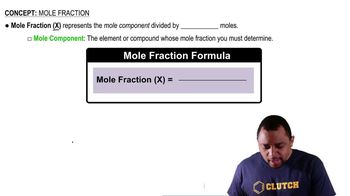When HNO2 is dissolved in water, it partially dissociates according to the equation HNO2 ⇌ H+ + NO2-. A solution is prepared that contains 7.050 g of HNO2 in 1.000 kg of water. Its freezing point is -0.2929 °C. Calculate the fraction of HNO2 that has dissociated.
Ch.14 - Solutions

Chapter 14, Problem 117
The vapor pressure of carbon tetrachloride, CCl4, is 0.354 atm, and the vapor pressure of chloroform, CHCl3, is 0.526 atm at 316 K. A solution is prepared from equal masses of these two compounds at this temperature. Calculate the mole fraction of the chloroform in the vapor above the solution. If the vapor above the original solution is condensed and isolated into a separate flask, what will the vapor pressure of chloroform be above this new solution?
 Verified step by step guidance
Verified step by step guidance1
Determine the molar masses of carbon tetrachloride (CCl4) and chloroform (CHCl3).
Calculate the number of moles of each compound using the formula: number of moles = mass / molar mass. Since the masses are equal, use the same mass value for both compounds.
Calculate the mole fraction of chloroform in the solution using the formula: mole fraction of CHCl3 = moles of CHCl3 / (moles of CCl4 + moles of CHCl3).
Use Raoult's Law to find the partial vapor pressures of each component in the solution. For each compound, multiply the mole fraction of the compound in the solution by its pure vapor pressure.
Calculate the total vapor pressure of the solution by adding the partial vapor pressures of CCl4 and CHCl3. Then, find the mole fraction of chloroform in the vapor phase using the formula: mole fraction of CHCl3 in vapor = partial pressure of CHCl3 / total vapor pressure.

Verified video answer for a similar problem:
This video solution was recommended by our tutors as helpful for the problem above.
Video duration:
6mWas this helpful?
Key Concepts
Here are the essential concepts you must grasp in order to answer the question correctly.
Vapor Pressure
Vapor pressure is the pressure exerted by a vapor in equilibrium with its liquid or solid phase at a given temperature. It reflects the tendency of particles to escape from the liquid phase into the vapor phase. The higher the vapor pressure, the more volatile the substance. In this question, the vapor pressures of carbon tetrachloride and chloroform are essential for determining the composition of the vapor above the solution.
Recommended video:
Guided course

Raoult's Law and Vapor Pressure
Raoult's Law
Raoult's Law states that the vapor pressure of a solvent in a solution is directly proportional to the mole fraction of the solvent in the solution. This principle allows us to calculate the partial pressures of each component in a mixture. In this scenario, Raoult's Law will be used to find the mole fraction of chloroform in the vapor above the solution, based on the known vapor pressures and the composition of the solution.
Recommended video:
Guided course

Raoult's Law and Vapor Pressure
Mole Fraction
Mole fraction is a way of expressing the concentration of a component in a mixture, defined as the number of moles of that component divided by the total number of moles of all components in the mixture. It is a dimensionless quantity that helps in calculating various properties of solutions, including vapor pressures. In this question, calculating the mole fraction of chloroform in the vapor is crucial for understanding the behavior of the solution and its components.
Recommended video:
Guided course

Mole Fraction Formula
Related Practice
Textbook Question
1
views
Textbook Question
A solution of a nonvolatile solute in water has a boiling point of 375.3 K. Calculate the vapor pressure of water above this solution at 338 K. The vapor pressure of pure water at this temperature is 0.2467 atm.
3
views
Textbook Question
The density of a 0.438 M solution of potassium chromate (K2CrO4) at 298 K is 1.063 g/mL. Calculate the vapor pressure of water above the solution. The vapor pressure of pure water at this temperature is 0.0313 atm. (Assume complete dissociation of the solute.)
Textbook Question
Find the mass of urea (CH4N2O) needed to prepare 50.0 g of a solution in water in which the mole fraction of urea is 0.0770.
